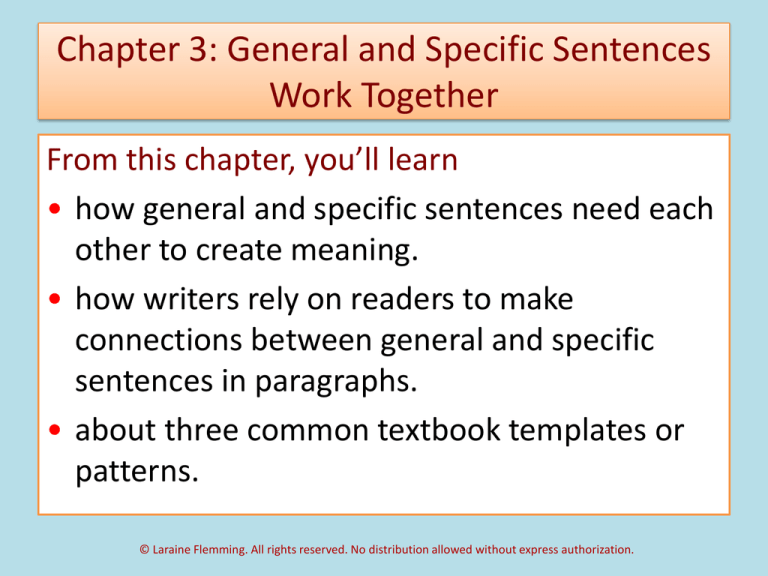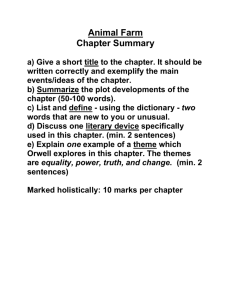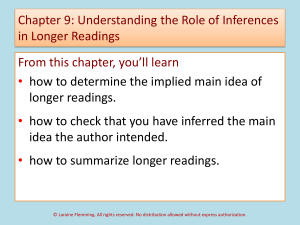
Chapter 3: General and Specific Sentences
Work Together
From this chapter, you’ll learn
• how general and specific sentences need each
other to create meaning.
• how writers rely on readers to make
connections between general and specific
sentences in paragraphs.
• about three common textbook templates or
patterns.
© Laraine Flemming. All rights reserved. No distribution allowed without express authorization.
© Ulrich Flemming
A Word to the Wise
Sentences cannot be considered general
or specific in isolation. The two terms only
make sense when sentences are used in
context, or in relation to one another.
© Laraine Flemming. All rights reserved. No distribution allowed without express authorization.
What Being “More General” Means When
It Comes to Words
The words products, communication,
entertainer, and sports are all more general
because
• they increase the number of things that can be
referred to, e.g., The word products can refer to bleach,
laptops, and Oreos among numerous other things.
• the things referred to by these words are more
different than similar, e.g., cookies, cleansers, and
computers are all “products.”
© Laraine Flemming. All rights reserved. No distribution allowed without express authorization.
Making General Words More Specific
General Words
• Sounds
• Movement
• Feeling
• Object
• Creature
• Location
• Product
More Specific Words
• Whistle
• Sprint
• Passion
• Guitar
• Dragon
• Chile
• Sneakers
© Laraine Flemming. All rights reserved. No distribution allowed without express authorization.
Defining Terms
Like General Words, General Sentences
• combine, summarize, or comment on a number of different
but related events, experiences, ideas, people, e.g.,
Many animals are capable of heroism.
• are broad in meaning and, therefore, provoke questions,
e.g., What kinds of animals? What kinds of heroism?
• cover a lot of territory and therefore can be misunderstood,
e.g., Think about the statement, “War is hell.” Would a
Marine and an anti-war protestor interpret it in the same
way?
© Laraine Flemming. All rights reserved. No distribution allowed without express authorization.
Defining Terms
Like Specific Words, Specific Sentences
• cover less ground than general ones.
• focus on fewer events, ideas, experiences, and
people.
• help explain or clarify general ones.
• answer questions readers might raise about
general sentences.
© Laraine Flemming. All rights reserved. No distribution allowed without express authorization.
Examples of General Sentences
• Abstract expressionist painters changed the
way Americans defined art.
• Television journalism is powered more by
ratings than news.
• The Internet has revolutionized education.
• Cell phones have had a dramatic effect on
the plots of romance novels.
© Laraine Flemming. All rights reserved. No distribution allowed without express authorization.
Examples of More Specific Sentences
•
The American abstract expressionist Willem DeKooning
created a series of paintings about women, but the women
looked like no female ever seen on planet Earth.
•
Television anchors are no longer seasoned reporters;
what counts is their audience appeal, not their experience.
•
Each year, more courses are partially or fully taught online.
•
Lovers can no longer miss each other at the airport and fail to
discover that the beloved was actually waiting on another
floor; in a novel set in the present, readers would wonder
why the idiots didn’t use their cell phones.
© Laraine Flemming. All rights reserved. No distribution allowed without express authorization.
© Ulrich Flemming
Just So You Know
The abstract expressionists were a group of
American artists, who, in the fifties, put the United
States in the forefront of the art world. They rejected
traditional realism and focused instead on line, color,
and shape. Probably the most famous members of
the group were Willem DeKooning, Jackson Pollock,
and Mark Rothko.
© Laraine Flemming. All rights reserved. No distribution allowed without express authorization.
Understanding General and Specific
Sentences in Context
Of the two sentences that follow, which is more
specific?
• Love is blind.
• People in the grip of love usually find it
extremely difficult to accurately evaluate
those they love.
© Laraine Flemming. All rights reserved. No distribution allowed without express authorization.
Understanding General and Specific
Sentences in Context
What happens, though, when you put that same
sentence in a different context?
1. People in the grip of love usually find it
extremely difficult to accurately evaluate
those they love.
2. Because they love their children, parents are
often blind to their flaws.
© Laraine Flemming. All rights reserved. No distribution allowed without express authorization.
General and Specific Sentences in Writing
Particularly in textbooks, writers frequently
• describe how a number of different events
or experiences turned out, e.g., “During World
War II, propaganda became a powerful tool.”
• summarize a prevailing point of view,
for instance, “President Lyndon Johnson’s
supporters turned against him over the
Vietnam War.”
© Laraine Flemming. All rights reserved. No distribution allowed without express authorization.
General and Specific Sentences in
Writing
To make sure readers understand the
general statements in the text, writers offer
more specific statements that
• explain.
• illustrate.
• convince.
• define.
© Laraine Flemming. All rights reserved. No distribution allowed without express authorization.
General and Specific Sentences in
Reading
Readers have to make connections between the
general and specific statements. Among other
things, they need to recognize how
•
•
•
•
•
illustrations clarify generalizations.
reasons support claims.
events lead up to outcomes.
causes produce consequences.
similarities and differences create comparisons.
© Laraine Flemming. All rights reserved. No distribution allowed without express authorization.
When General Sentences Become Topic Sentences
General sentences that sum up the point of the
paragraph are called Topic Sentences.
Topic Sentences do two things:
1. Refer to the topic of the paragraph.
2. Tell you, in broad terms, what the author wants
to say about the topic. In other words, they
give you the main idea.
© Laraine Flemming. All rights reserved. No distribution allowed without express authorization.
Topic Sentences in Textbooks
As readers, it helps to know how
textbook authors are likely to distribute
general and specific sentences, for
instance:
© Laraine Flemming. All rights reserved. No distribution allowed without express authorization.
Three Common Topic Sentence Locations in
Textbooks
1. Topic Sentence Opens the Paragraph.
2. An Introductory Sentence Opens the
Paragraph and is Followed by the Topic
Sentence.
3. Specific Sentences Build Up to the Topic
Sentence which comes at the end.
© Laraine Flemming. All rights reserved. No distribution allowed without express authorization.
Explanatory Pattern 1: Starting with the Topic Sentence
All chile peppers—from the mildest green and red bell
peppers to the hottest habaneros (peppers one author
refers to as “thermonuclear”) have one ancestor in
common. They all belong to the genus, or class,
Capsicum. People in what is now South and Central
America started growing chile peppers 10,000 years
ago. Today, plant breeders grow hundreds of varieties
of chile plants, virtually all belonging to just one
species, Capisicum annum. Capisicum annum is the
most widely spread plant species in the world, because
chile peppers are the most widely used cooking spice.
© Laraine Flemming. All rights reserved. No distribution allowed without express authorization.
Explanatory Pattern 2: Starting with an Introduction
In the 1870s, pioneer photographer William Henry Jackson explored
vast areas of the West with his camera, making Americans aware of
the beauty to be found in places like the Colorado Rockies. Yet
despite Jackson’s undisputed talent, his success as a photographer
was the consequence of a broken heart rather than careful planning.
When his sweetheart, Caroline Eastman, rejected his proposal of
marriage, he picked up his camera and went West. In an effort to get
Caroline out of his mind, he visited remote areas with the geologist
Ferdinand Vandeveer Hayden. Jackson’s photos became the first
published images of what would one day become Yellowstone
National Park. He was also the first one to photograph prehistoric
dwellings of Native-Americans in Mesa Verde, Colorado. But he
never forgot Caroline. When he died at the age of ninety-nine, he
still had her picture next to his heart.
© Laraine Flemming. All rights reserved. No distribution allowed without express authorization.
Explanatory Pattern 3: Ending with the Topic
Sentence
In March of 1964, Catherine “Kitty” Genovese was stabbed to
death outside of her apartment for a period of twenty-five
minutes. During that time, thirty-five people watched from the
safety of their apartments as the killer returned twice to finish
his attack, after being interrupted by someone shouting from a
window. To this day, no one can fully explain why no one called
the police during the attack. One theory is that every person
watching thought someone else would make the call. What is
known is that the attack on Catherine Genovese is one of the
worst cases of shameless public apathy to ever go on record.
© Laraine Flemming. All rights reserved. No distribution allowed without express authorization.
© Ulrich Flemming
Finishing Up: General and Specific
Sentences Work Together
You’ve previewed the major concepts and
skills introduced in Chapter 3. Take this
quick quiz to test your mastery of those
skills and concepts, and you are ready to
read the chapter.
© Laraine Flemming. All rights reserved. No distribution allowed without express authorization.
Finishing Up: General and Specific
Sentences Work Together
1. True or False. The more general a sentence is,
the more likely it will focus on a single
experience or event.
2. True or False. Sentences can only be labeled
general or specific in relation to one another.
3. True or False. General sentences need specific
ones for clarification, but specific ones can
stand alone.
© Laraine Flemming. All rights reserved. No distribution allowed without express authorization.
Answers 1-3
• Answer 1: False The more general a sentence
is, the more likely it is to embrace numerous
and very different individuals, events, and
experiences.
• Answer 2: True A sentence that is specific in
one context might be general in another.
• Answer 3: False Sometimes a sentence more
specific than the topic sentence also needs
clarification and is not completely clear on its
own.
© Laraine Flemming. All rights reserved. No distribution allowed without express authorization.
Finishing Up: General and Specific
Sentences Work Together
4. True or False. General sentences are
more open to being misunderstood than
specific ones are.
5. True or False. Writers need to think
about the relationship between general
and specific sentences, but readers don’t.
© Laraine Flemming. All rights reserved. No distribution allowed without express authorization.
Answers 4-5
Answer 4: True The more general a sentence is,
the more it refers to a greater number of events,
individuals, and experiences, making it more
open to misinterpretation.
Answer 5: False Readers need to think about
general and specific sentences as much as writers
do. They need to recognize general sentences to
get the author’s point and specific sentences to
make sure they understand it.
© Laraine Flemming. All rights reserved. No distribution allowed without express authorization.
© Ulrich Flemming
Brain Teaser Challenge 1
Based on your understanding of what
you’ve learned from the slides, how
would you explain this quotation from
the novelist Iris Murdoch?
“We Tame the World by Generalizing.”
© Laraine Flemming. All rights reserved. No distribution allowed without express authorization.
Brain Teaser Challenge 2
What is the connection between the short story
described here and the quote from Murdock?
“Funes, His Memory” is a short story by the Argentine
writer Jorge Luis Borges. In the story, Funes is a teenage
boy who survives a horse riding accident. After his
accident, he remembers every detail of what he sees or
hears. He can remember all the individual parts of things,
but has great difficulty naming them. He is, as Borges
says, “haunted by details.”
© Laraine Flemming. All rights reserved. No distribution allowed without express authorization.









